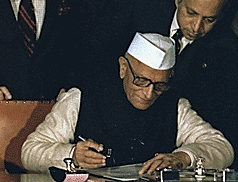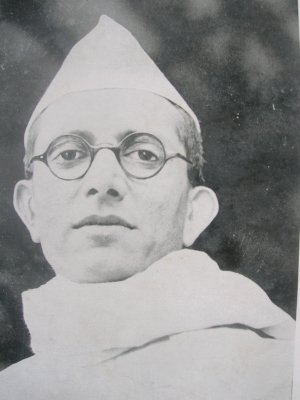Morarji Desai
| Morarji Desai | |

| |
| In office 24 March 1977 – 15 July 1979 | |
| President | Basappa Danappa Jatti and Neelam Sanjiva Reddy |
|---|---|
| Preceded by | Indira Gandhi |
| Succeeded by | Choudhary Charan Singh |
| In office 21 August 1967 – 26 March 1970 | |
| Preceded by | T. T. Krishnamachari |
| Succeeded by | Indira Gandhi |
| In office 15 August 1959 – 29 May 1964 | |
| Preceded by | Jawaharlal Nehru |
| Succeeded by | T. T. Krishnamachari |
| Born | February 29 1896 Bhadeli, Bombay Presidency, British India |
| Died | April 10 1995 (aged 99) New Delhi, India |
| Political party | Congress (up to 1969), Congress(O) (1969-1977), Janata Party |
| Occupation | Civil servant, Activist |
| Religion | Hindu |
Morarji Ranchhodji Desai (Hindi: मोरारजी देसाई) (February 29, 1896 – April 10, 1995) was an Indian independence activist and the Prime Minister of India from 1977-79. He was the first Indian Prime Minister who did not belong to the Indian National Congress. He is the only Indian to receive the highest civilian awards from both India and Pakistan, namely the Bharat Ratna and Nishaan-e-Pakistan.
Early life
Morarji Desai was born into an Anavil Brahmin family in Bhadeli, Valsad in Bombay Presidency (now in Gujarat). After graduating from Wilson College, Mumbai, he joined the civil service in Gujarat. Later, he left the service of the British in 1924 and joined the civil disobedience movement against British rule in India in 1930. He spent many years in jail during the freedom struggle and owing to his sharp leadership skills and tough spirit, he became a favourite amongst freedom-fighters and an important leader of the Indian National Congress in Gujarat. When provincial elections were held in 1934 and 1937, Desai was elected and served as the Revenue Minister and Home Minister of the then Bombay Presidency.
In government
Before the independence of India, he became Bombay's Home Minister and later was elected as Chief Minister of Bombay in 1952. The state was home to Marathi linguistic movements, with calls for the creation of a separate linguistic state. Considered as a tough leader, Desai was also known for pioneering beliefs and enforcing strict discipline and authority and thus possessed a radical mindset. By Desai's orders in 1960, a demonstration by the Samyukta Maharashtra Samiti was fired upon by the police resulting in the deaths of 105 demonstrators. 105 demonstrators were killed in the incident leading to public outrage that shook the central government. The incident led to the formation of the present State of Maharashtra.
As Home Minister, Desai outlawed any portrayals of indecency (which included "kissing" scenes) in films and theatrical productions. Although a staunch Gandhian, Desai was socially conservative, pro-business, and in favour of free enterprise reforms, as opposed to Prime Minister Jawaharlal Nehru's socialistic policies.
Rising in Congress leadership, Desai was at odds with Prime Minister Nehru and his allies, and with Nehru's age and health failing, he was considered as a possible contender for the position of Prime Minister. Outflanked in the leadership contest after Nehru's death in 1964 by the Nehruvian Lal Bahadur Shastri, Desai remained content to build support within the ranks.
After Shastri's death in 1966, he contested for Prime Minister and fought a closely-contested election with Indira Gandhi. Desai obtained 169 votes but lost to Indira Gandhi who garnered 351.
Split of 1969
Initially Desai stayed out of the Cabinet, biding his time. As the young Indira Gandhi s government became embroiled in controversy following a poor harvest, currency devaluation, and rising disenchantment in the country, Desai's influence grew in strength and he returned to the Cabinet in 1967. He demanded the powerful position as the Minister for Home Affairs, but he settled for the Ministry for Finance, with the added title of Deputy Prime Minister. Relations between Desai and the young Prime Minister were strained at best.
In 1969, Indira Gandhi and her allies engineered a major schism in the Congress Party, and her leftist supporters within the Congress Party formed the Congress (R), later to become the Congress (I) Party. Desai and the rest of the Congress establishment cohered to form the Congress (O) Party. But in the General Elections held in 1971, the Congress (O) was drubbed owing to Indira Gandhi's popularity.
When Prime Minister Indira Gandhi was convicted in June 1975 of wrongfully using government machinery for election work and corruption, Desai joined Jaya Prakash Narayan in organising mass protests throughout the country calling for her resignation. In a show of intolerance towards any sort of opposition, Indira Gandhi declared Emergency and had all the opposition leaders including Desai arrested.
When Indira called for elections in January 1977, many opposition groups, including the Congress (O), joined with longtime rivals, regional parties and blocs of rival ideologies to form the Janata Party. It won 356 seats, close to 2/3 majority, and for the first time since independence, the dominance of the ruling Congress Party was broken. Morarji Desai finally came into office as the Prime Minister when Jaiprakash Narayan picked him as the man most likely to keep the coalition united.
At the time, he was 81 years old but still healthy and vigorous, without any particular ailments.
Prime Minister
Desai led a fractious coalition government, and thus failed to achieve much owing to continuous in-wrangling and much controversy. With no party in leadership of the coalition, rival groups vied to unseat Desai. Controversial trials of prominent Congress leaders, including Indira Gandhi over Emergency-era abuses worsened the fortunes of his administration. Desai worked to improve relations with neighbour and arch-rival Pakistan and restored normal relations with China, for the first time since the 1962 war. He communicated with Zia-ul-Haq and established friendly relations and diplomatic relations were also re-established with China. His government undid many amendments made to the constitution during emergency and made it difficult for any future government to impose national emergency.
Since India's first nuclear test in 1974, Desai kept India's nuclear reactors stating "they will never be used for atomic bombs, and I will see to it if I can help it".[1] In 1977, the Carter administration sold India, heavy water and uranium for its nuclear reactors but required American on-site inspection of nuclear materials. Desai declined, seeing the American stance as contradictory, in light of its own nuclear arsenal. [2]
Retirement and death
In 1979, Charan Singh pulled out of the Janata Party, forcing Desai to resign from office and retire from politics at the age of 83. Desai campaigned for Janata Party in 1980 General Election as a senior politician but did not contest the election himself.
In retirement, he lived in Bombay, and died at the age of 99. He had been honoured much in his last years a freedom-fighter of his generation.
Kanti Desai, Morarji Desai's son, was often criticized for being corrupt and using his father's name as an influence. During Desai's retirement, the family was evicted by a court order from their apartment in Mumbai occupied illegally. Sharad Pawar, then Chief Minister of Maharashtra, offered the family an apartment for the remainder of Morarji Desai's life, and the family moved there.
Morarji Desai was a strict follower of Mahatma Gandhi's principles and a moralist.
Feud with RAW
Morarji Desai had described the RAW as the praetorian guard of Indira Gandhi and had promised to stop all activities of the RAW after becoming prime minister. B. Raman, the former head of the Counter-Terrorism Division of India's external intelligence agency, the Research and Analysis Wing (R&AW),reveals that, in an unguarded moment, Indian prime minister Morarji Desai indiscreetly told Pakistani dictator Zia ul-Haq that he was aware of Islamabad's nuclear schemes.
Auto urine therapy
Morarji Desai practised "auto urine therapy" (drinking one's own urine) to keep fit. In an interview, he stated that he was afflicted with piles in his 40s and was advised to try out drinking shivambu. (shiv=holy, ambu=water; in the therapy, urine is called 'shivambu'.) He felt benefits of the therapy within a week, and was soon completely cured. He continued the therapy for the rest of his life and argued for its curative effects on health.
Social Service
Morarji Desai was a true Gandhian follower, social worker, institution builder and a great reformer. He was the Chancellor of Gujarat Vidyapith (university established by Mahatma Gandhi). Even during his term as the Prime Minister he used to visit and stay at Vidyapith during the month of October. He exemplified simplicity and used to write post card himself even when he held the office of Prime Minister. Sardar Patel deputed him to conduct meetings of farmers in Kaira district which finally led to establishment of AMUL Cooperative movement. During his rule, he withdrew intervention in Public Distribution System and rationing shops were literally lost due to cheap sugar and oil available in the market.
ReferencesISBN links support NWE through referral fees
External links
- Moraji Desai Biography
- The Return of the Rosebud TIME - Jan 28, 1966
| Preceded by: Jawaharlal Nehru |
Finance Minister of India 1959–1964 |
Succeeded by: Tiruvellore Thattai Krishnamachariar |
| Preceded by: Tiruvellore Thattai Krishnamachariar |
Finance Minister of India 1967–1970 |
Succeeded by: Indira Gandhi |
| Preceded by: Indira Gandhi |
Prime Minister of India 1977–1979 |
Succeeded by: Choudhary Charan Singh |
| |||||
de:Morarji Desai fr:Morarji Desai hi:मोरारजी देसाई kn:ಮೊರಾರ್ಜಿ ದೇಸಾಯಿ ml:മൊറാര്ജി ദേശായി mr:मोरारजी देसाई no:Morarji Desai pl:Morarji Desai ro:Morarji Desai ru:Десаи, Морарджи sa:मोरारजी देसाई sv:Morarji Desai ta:மொரார்ஜி தேசாய் te:మొరార్జీ దేశాయి tr:Morarji Desai zh:莫拉尔吉·德赛
Credits
New World Encyclopedia writers and editors rewrote and completed the Wikipedia article in accordance with New World Encyclopedia standards. This article abides by terms of the Creative Commons CC-by-sa 3.0 License (CC-by-sa), which may be used and disseminated with proper attribution. Credit is due under the terms of this license that can reference both the New World Encyclopedia contributors and the selfless volunteer contributors of the Wikimedia Foundation. To cite this article click here for a list of acceptable citing formats.The history of earlier contributions by wikipedians is accessible to researchers here:
The history of this article since it was imported to New World Encyclopedia:
Note: Some restrictions may apply to use of individual images which are separately licensed.
